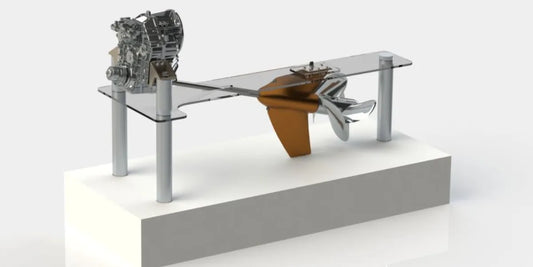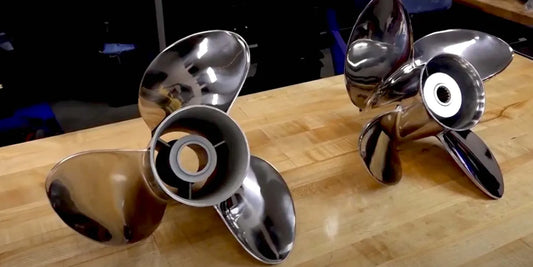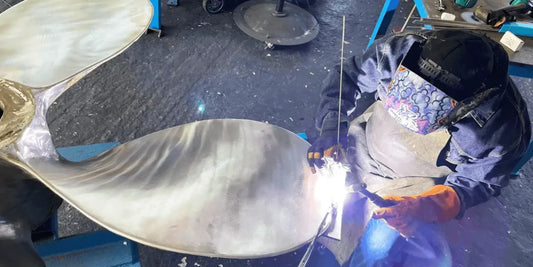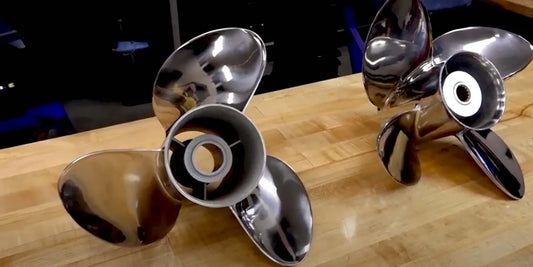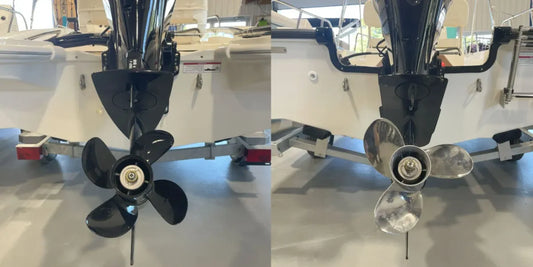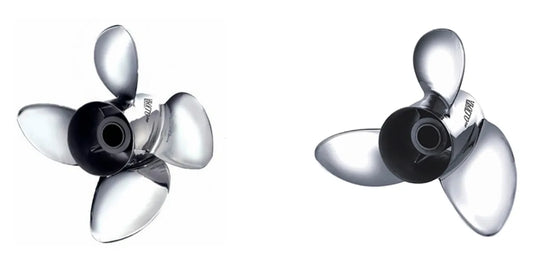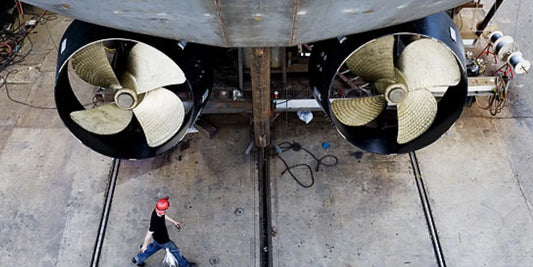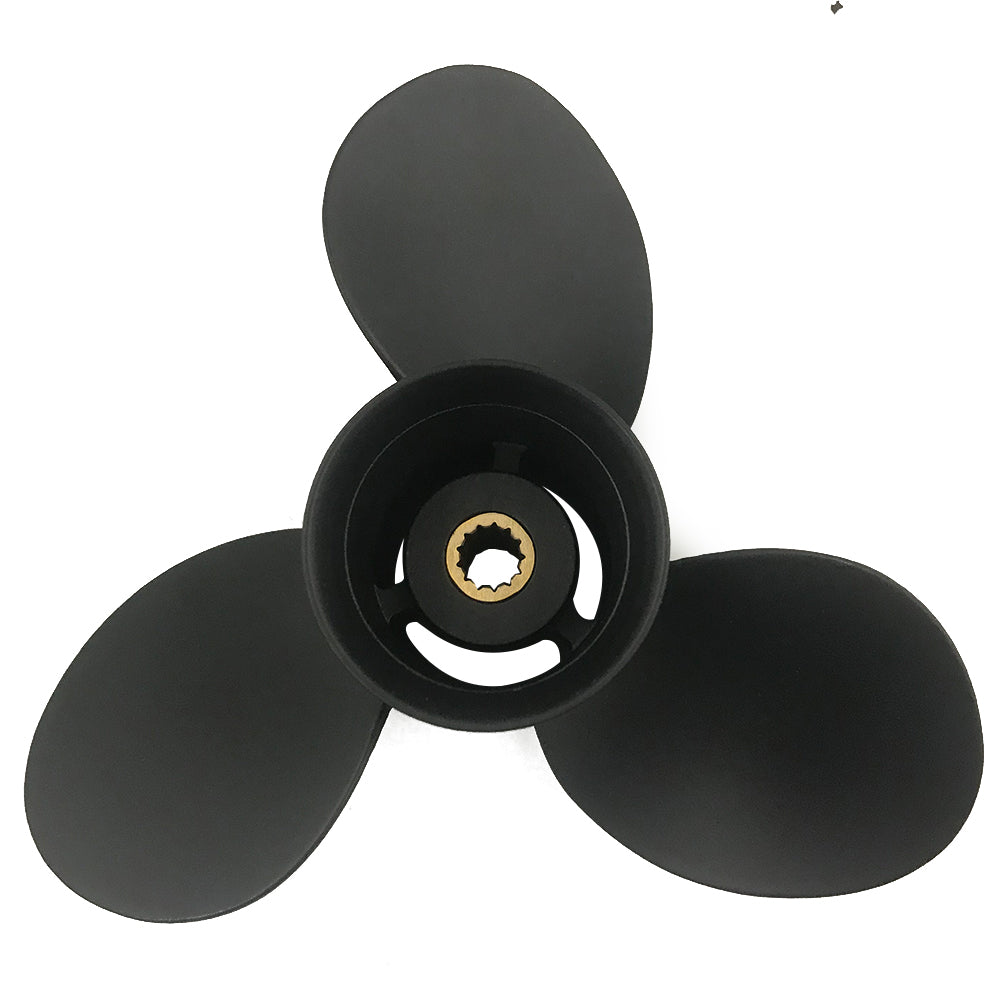When it comes to fine-tuning the mechanical application of two types of materials, aluminum and stainless steel, two main reasons usually arise: firstly, due to the difference in performance, and secondly, because of the expected durability. Whether lacing for speed, fuel efficiency, or handling, it is essential to understand the fundamental differences between aluminum and stainless steel propellers. This guide covers all the finer points, from cost and maintenance to strength and efficiency, so that you can select the perfect propeller for your boating needs. Stay put as we unlock the entire toolbox of pros and cons of aluminum versus stainless steel, ensuring that your boat trips are smooth, efficient, and tailored perfectly for your vessel.
Understanding Propeller Materials

Introduction to Aluminum and Stainless Steel
Aluminum and stainless steel are among the most commonly used materials in boat propellers, each having its advantages depending on the priorities and conditions of the boatman. Aluminum propellers are lightweight and cost-effective, making them ideal for casual boaters and those operating in shallower waters where a ground strike may occur accidentally. The design of aluminum propellers improves durability while also making them relatively easy to repair, thereby lessening long-term maintenance costs.
Stainless steel holds a distinguished position for its strength and performance. It can withstand much higher stresses, making it preferable for high-speed operations that require precision in handling. Corrosion-resistant and capable of withstanding saltwater environments, this type of propeller lasts longer. Stainless steel propellers, although more expensive upfront, have a definite depreciation compared to aluminum, which proves to be a better investment for the serious fisherman seeking the very best in efficiency and performance. All of these considerations contribute to a better-informed choice, taking into account your specific requirements, including cost, durability, and functionality.
Key Differences between Aluminum and Stainless Steel
Weight and Performance: Aluminum is much lighter than stainless steel. This results in improved fuel economy and faster acceleration, particularly with lighter boats. On a lighter note, it can also mean lesser strength and durability, thus giving aluminum a higher tendency to bend or warp under stress. While heavier, stainless steel can bring strength and rigidity to better perform in high-speed and rough conditions.
Durability and Lifespan: Aluminum propellers tend to be damaged by impact and debris due to their softer texture. At the same time, stainless steel propellers offer exceptional durability. They can withstand heavier impacts, making them ideal for those who frequently navigate waters filled with rocks or debris.
Cost Considerations: Aluminum propellers are more affordable to purchase upfront and easier to fit within the budget of the casual boater. However, stainless steel propellers, which require fewer repairs and less frequent replacement over the years, truly provide the best long-term value.
Corrosion Resistance: They are guaranteed to resist corrosion; however, stainless steel performs significantly better than aluminum in a saltwater environment. Aluminum propellers are often treated to prevent corrosion, but when exposed to corrosive elements for an extended period, they become susceptible to pitting or damage. Given its superior corrosion resistance, stainless steel is mainly preferred in saltwater applications.
Flexibility and Customization: Aluminum propellers typically offer limited options in terms of blade designs and performance features. Being stronger, stainless steel propellers can adopt more advanced designs such as thinner blades and higher rake angles that increase overall efficiency and handling.
Suitability for Application: When used recreationally in calm freshwater environments, aluminum propellers are typically adequate and affordable. Stainless steel propellers, meanwhile, are in higher demand for high-performance boating, commercial use, and navigating challenging marine environments, where reliability and efficiency are crucial.
Considering the differences in weight, performance, durability, cost, corrosion resistance, and application requirements, propeller material selection ensures the optimal promotion of efficiency, longevity, and affordability for each individual.
Performance Characteristics of Propellers
Several vital characteristics determine the performance of propellers, each having a higher influence on maximizing marine efficiency and functionality. The most important of these parameters are pitch, diameter, blade type, material, and blade number.
Pitch and Diameter: These two features directly affect thrust and speed. A high-pitch propeller drives the boat to speed with ease but lowers acceleration, making it attractive for long-distance cruising. A lower pitch is suitable for acceleration and is used when water skiing and making quick maneuvers. Diameter, in contrast, defines the quantity of water propelled by the propeller, resulting in increased thrust, which is more pronounced in heavier boats.
Blade Design and Shape: Blade surface area and design underlie hydrodynamic realizations. Generally, more blades mean decreased vibrations and noise. Some specific design features, such as cupping, provide a better grip for the water, improving acceleration and minimizing slippage, which is particularly useful in shallow or turbulent water.
Effects of Materials: Aluminum blades offer a compromise between cost and durability. Stainless steel propellers, however, are stronger, flex less at high speeds, and are more corrosion-resistant, offering higher performance in harsh marine conditions.
Blade Rake and Skew: Rake is the angle at which the blades are set concerning the hub. High rake angles perform well on high-speed boats by providing good grip and lift. Skewed blades reduce vibration and noise, resulting in smoother operation.
Ventilation and Cavitation: Air should be drawn to the back of the blade, not in front of it, as this reduces drag and improves efficiency. Cavitation occurs when air bubbles form near the blade surfaces, hindering performance and eventually damaging the propeller. Great design and maintenance keep it from happening.
In-depth knowledge of the above characteristics, combined with tuning them to a practical combination suitable for the vessel, its size, engine power, and intended purpose, will guarantee the highest propulsion efficiency, fuel economy, and reliability for any marine application.
Advantages of Aluminum Propellers

Weight and Maneuverability
Aluminum propellers are renowned for their lightweight construction, which significantly enhances a vessel's maneuverability.</span> Higher weight means a greater strain on the engine, leading to slower acceleration and the inability to make quick changes in direction. Conversely, lightweight aluminum offers smoother handling, making propellers ideal for use in smaller and mid-sized boats that require precise maneuvering in narrow, shallow waterways. Considering that aluminum props put less weight on the gearbox, they also increase the working efficiency of the drive components, thereby prolonging the life of essential elements.
Aluminum propellers offer excellent value and good performance compared to heavier types, such as stainless steel. The lightweight propellers allow for greater fuel savings because the less power needed to drive a propeller, the more power is converted into practical work. This reduction in fuel consumption consequently decreases the operating costs, especially for recreational and commercial operators interested in optimizing fuel consumption as much as possible. Aluminum is an excellent material that can be coated or customized to resist corrosion and fatigue, thereby increasing longevity even in harsh marine environments. This is why aluminum propellers are widely used in various maritime fields and, in return, promise great value for money.
Cost-Effectiveness of Aluminum Props
Aluminum propellers strike a perfect balance between performance and cost, which is why commercial operators and recreational boaters seek cost-effective options. Their major selling points are relatively lower production costs compared to other alternatives, such as stainless steel. This renders aluminum propellers at a significantly lower cost, making them especially beneficial for individuals or organizations on a tight budget. Furthermore, due to their low weight, they promote fuel savings by placing a lighter burden on the engine, which in turn reduces the vessel's operational cost in the long run.
While maintaining affordability, aluminum propellers provide excellent service and versatility. They are flexible and can be customized to meet the needs of certain situations and boat types, thereby maximizing the performance of a broad spectrum of marine activities. Industry innovations in aluminum alloys have complemented their durability, allowing many aluminum propellers on the market today to offer high resistance to wear and corrosion from impact in both coarse saltwater and freshwater environments. This means aluminum propellers provide greater longevity, resulting in fewer replacements and savings for the boat owner over time.
Additionally, aluminum propellers are easier to repair compared to stainless steel ones, whose repairs are typically more costly. This property of aluminum is advantageous for boaters in the event of slight damage, as repairs can be administered quickly and at reduced costs. Coupled with their mass manufacturing and adaptability, aluminum propellers are a money-well-spent solution available in the market today, thereby ensuring their future acceptance by the marine industry.
Aluminum Props: Best Uses
Aluminum propellers are ideally suited for smaller recreational boats and light-duty applications where cost efficiency and versatility are considered. These propellers are designed for navigating shallow water services, which occur occasionally due to their lightweight nature, facilitating easy handling and a decreased risk of damage. For example, in the fishing boats or pontoon boats, aluminum propellers find their way quite easily where reduced top speeds and moderate power output suffice.
Another primary application is for boat owners seeking an affordable option for occasional or seasonal use. Aluminum propellers perform well with mid-range horsepower engines, providing dependable thrust and responsive service at an inexpensive price. Equipped with the improved performance and durability provided by advancements in materials and manufacturing, aluminum propellers are well-suited for many general-purpose marine vessels.
Benefits of Stainless Steel Propellers

Durability and Resistance to Corrosion
Stainless steel propellers are enormously durable and corrosion-resistant, given that corrosion resistance is mainly a function of the strength and composition of the alloy. These propellers are made from stainless steel varieties containing chromium, which develops an oxide layer on the surface to protect the material from rust and corrosion. Such excellent resistance to corrosion renders this category of stainless steel propellers particularly suitable for use in saltwater conditions, as these adverse marine environments would quickly deteriorate other materials. Moreover, with high strength, stainless steel propellers can withstand severe impacts and abrasions, thereby increasing the propeller's lifespan and reducing maintenance costs for boat owners.
With the evolution of manufacturing techniques and new design trends, the performance and lifespan of stainless steel propellers have also been enhanced. The improvements in casting and finishing techniques, optimized compositions in stainless steel alloys, and various designs enable manufacturers to produce propellers with significantly better hydrodynamic shapes and structural integrity. For example, due to their thin, rigid blades that reduce drag through water, modern stainless steel propellers usually give more fuel savings and faster speeds than aluminum props. These performance advantages, along with the structural integrity required to operate at high RPMs, rank among the most significant reasons for this choice among boating enthusiasts, offering ultimate reliability and efficiency.
Additionally, stainless steel propellers gain an edge as a versatile application across the diverse marine realm. These reliable propellers can be installed in any type of recreational boat, ranging from leisure to sport-fishing variants, and are highly reliable for all engine types and conditions in open water. Stainless steel propellers would mean a stone in favor of durability and performance. Hence, they would be the best choice for anyone seeking to give their boating experience that additional edge, already endowed with a little bit of their expertise.
High-Speed Performance
Due to their rugged construction and aerodynamic efficiency, stainless steel propellers thrive in high-speed conditions. These propellers are specifically designed to operate with minimal flexing under extreme pressure, maintaining consistent performance at peak speeds. This rigidity enables the design form and blade angle to be held more precisely, resulting in a significant reduction in drag and an enhancement of thrust. The result is a smooth, controlled ride under demanding conditions or choppy waters, making stainless steel propellers an obvious choice for watercraft.
By virtue of their high-speed operation, they also maintain better acceleration and grip. Aluminum propellers are prone to slipping under such extreme forces, but stainless steel propellers do not let go of the water forced through the blades. It ensures swift responsiveness in tall waters or sharp turning movements. In addition, stainless steel propellers generally boast advanced designs, incorporating innovative cupping and pitch variances, which lend to optimizing their speed and propulsion functions, enabling vessels to traverse faster while remaining stable and in control.
For maximum fuel efficiency without compromising speed, stainless steel propellers are ideal for boaters. They complete this by ensuring smooth water flow around the blades and reducing turbulence through a precisely engineered design and their durability. Both fuel cost and environmental benefits are closely tied to this level of efficiency in hydrodynamic performance, with protests not to wear cost-determining factors, which strike the right balance for speedboats, underlining reliability and efficiency.
Areas Where Stainless Steel Propellers Are Best Utilized
Due to their strength, durability, and ability to withstand rigorous and harsh conditions, stainless steel propellers are excellent for a variety of maritime applications. They best fulfill the need for performance vessels that demand superior hydrodynamics and precision from a propeller, such as speedboats and performance marine craft. Their corrosion resistance also means they will provide dependable service for many years in salt water, even with constant exposure to its aggressive marine environment.
In all activities that involve towing boats, such as water skiing, wakeboarding, or fishing, enhanced thrust and efficiency from stainless steel blades will translate into improved towing experiences and better handling capabilities. These are also valuable tools for all commercial and recreational boaters who demand dependable performance, especially when carrying heavy loads or facing extreme weather conditions. Remaining versatile and exerting minimal flex while transferring maximum power, stainless steel propellers guarantee perfect performance and long life expectancy.
Comparative Analysis: Aluminum vs Stainless Steel Propellers

Performance Metrics: Speed and Efficiency
Although speed and efficiency are considered key performance parameters, stainless steel propellers often outperform aluminum ones due to their greater strength and design flexibility. The very rigidity of stainless steel enables the manufacture of fragile and accurately machined blades with significantly less drag, thereby achieving greater hydrodynamic performance and higher top-end speeds and fuel economy, especially in high-performance boating operations.
Aluminum propellers are lighter and less costly, making them advantageous for boaters who are casual in their boating and are keeping costs in mind. Yet they are of a softer material; hence, they tend to flex under higher speeds or heavier loads, thus hampering their efficiency and ability to attain speed. For general-purpose use in calmer waters, aluminum propellers would suffice.
The ultimate choice between aluminum and stainless steel depends on the boater's priorities. For those seeking increased speed, fuel efficiency, and durability over extended periods, stainless steel remains the best choice for performance applications.
Maintenance Requirements for Each Material
Maintenance of stainless steel or aluminum propellers differs, depending on the properties of each material. Although aluminum propellers are a good economical choice, they can also dent, bend, or corrode, especially in saltwater. Do keep the propellers under visual inspection to spot any damage. Aluminum propellers should always be washed immediately after use, especially after being run in salt water, to prevent corrosion of their surfaces. The application of an anti-corrosion coating or marine-grade paint as a preventive solution is also suggested.
In contrast, stainless steel propellers are durable and corrosion-resistant, thereby significantly lessening maintenance. That said, stainless steel propellers hardly ever get away without any wear and tear at all. It is good practice to check for nicks or scratches at regular intervals, as even small ones can hamper performance. They do require cleaning after use, particularly when operating in saltwater, to remove marine growth or any debris. Periodic polishing will keep the propellers looking great and prevent grime buildup, thereby ensuring optimal performance throughout their lifetime.
For both materials, it is crucial to routinely inspect the propeller's hub and mounting hardware for tightness and signs of wear. Seasonal maintenance and expediting the repair of minor issues will save significant costs and aid in the performance and longevity of the propeller.
Profitability Over Time: Initial Investment Vs. Longevity
The cost of a propeller is calculated not only based on its purchase price but also on whether maintenance or replacement is expected shortly. Aluminum propellers generally carry a lower price tag upfront and can therefore appease any budget-minded buyer. In contrast, they may demand at least some replacement from time to time, especially in a high-risk environment prone to impacts or abrasion.
The initial investment is considerably higher for stainless steel propellers, but this price is offset when one considers the lower repair and maintenance costs. Stainless steel propellers are robust and corrosion-resistant, thereby incurring minimal repair and replacement costs, especially for those who frequently operate in adverse environments, such as saltwater or hazardous areas, or those submerged. Due to energy-conversion enhancement, improved fuel economy is immediately realized by the user and further contributes to reducing operation costs during the propeller's lifetime.
A buyer needs a thorough understanding of their usage pattern, processing environment, and maintenance capability. The price reflects the market value; however, factors such as life, efficiency, and guaranteed performance will ultimately determine the actual investment in the long run.
Conclusion: Choosing the Right Propeller for Your Boat

Factors to Consider in Your Decision
When considering the right propeller for my boat, I know it is, or I must have suspected that it was, imperative to evaluate several components to obtain optimal service and value. The very first thing that comes to mind is the size and type of my boat, as they both heavily weigh on the kind of propeller that would best suit its needs. Larger boats tend to require heavier and stronger propellers, whereas smaller counterparts perform better with lighter and more responsive types. Also, I consider the horsepower of my engine and the use of my boat, that is, whether it is for speed, towing, or mere cruising, all of which have a direct bearing on the nature of the propeller required.
Another reasonable consideration is the choice of propeller material. Stainless steel and aluminum are the most common options, each having its advantages. For example, stainless steel propellers are considered the most durable and long-term performers, making them an excellent choice for use in harsh conditions. On the higher side of initial expenses comes aluminum, and yet it is worth less for casual or light-duty boating. Lastly, I consider the maintenance and availability of spare parts so that whichever I choose, I will be able to maintain it in optimum working condition in the long run. By carefully balancing these factors, I will be able to select a propeller that optimizes efficiency, longevity, and cost for my specific needs.
Final Thoughts on Aluminum and Stainless Steel Props
When choosing between aluminum and stainless steel props, my decision usually relies comprehensively on the specific needs and conditions in which I do my boating. Aluminum props are best suited for casual or recreational use because they are relatively inexpensive to purchase and can be easily found. They work perfectly for lighter boats and in cases where there may be minor hits or slight damage, as it will not be costly to have them repaired or replaced. On the contrary, stainless steel offers a significantly higher performance level and provides strength and durability for engines of higher power, even under adverse conditions or when the propeller is subjected to high and rigorous usage. It will cost more to buy, but if you factor in proper maintenance and durability, you will realize it is worth every penny.
For me, it will come down to striking a balance between economic stability and long-term performance. If waters are primarily calm, outings are rare, and I have a tight budget, aluminum is an option that will serve me well. Conversely, if my adventures come a little rough, I need pinpoint handling precision, or outright efficiency is just a must, stainless steel is a prideful choice to make. An evaluation of aspects such as the type of water, the engine's power, and the various ways I use my boat will enable an informed decision that aligns with my expectations.
Ultimately, no single solution is emerging. One has to bear in mind the benefits of each, alongside their challenges, and through personal experience, I have come to see that the best choice will always lie in understanding precisely what I need. Choosing by providing a precise analysis of one's priorities and environment leaves no doubt, and one can confidently put their money behind the propeller that delivers outstanding performance, Dependability, and Value for the best boating experience.
Reference Sources
-
Aluminum vs Stainless Steel Props - Michigan Wheel
Discusses differences in blade thickness, drag, and impact on speed. -
Aluminum vs. Stainless Steel Props: What's the Difference? - Boats.net
Highlights weight, stiffness, and horsepower considerations. -
Stainless Steel vs Aluminum Prop - iFish.net
Explores performance benefits like speed, grip, and cost differences. -
Is an Aluminum or Stainless Steel Propeller Right For You? - Boat Specialists
Guides engine compatibility and performance. -
Aluminum vs Stainless Steel Prop Buying Tips - Boat Specialists
Provides insights into selecting the appropriate propeller based on engine power.
Frequently Asked Questions (FAQs)
What are the differences between aluminum and stainless steel propellers?
Material properties are the fundamental differences between aluminum and stainless steel propellers. Aluminum propellers are lightweight and generally less expensive to manufacture, making them suitable for smaller boats and casual use. Stainless steel propellers are of significantly better quality in terms of durability and corrosion resistance; the unpredictable performance and handling in various water conditions are discussed. Aluminum may be sufficient for recreational purposes, but stainless steel is often preferred when higher speeds and more demanding applications are required.
How does stainless steel propeller durability compare to aluminum propellers?
Typically, stainless steel propellers are more durable than aluminum propellers. They can withstand torque and are resistant to bending or damage when hitting underwater obstacles, as bending or damage is a concern with aluminum props. For this reason, if you operate an outboard with stainless steel propellers in shallow water or rough conditions, performance and efficiency will be maintained throughout the life of the equipment.
Can I use aluminum propellers on my high-performance boat?
Aluminum propellers can be used on high-performance boats, but they usually don't perform as well as stainless steel propellers. For boats that require higher top speeds and handling capabilities, particularly if high speeds result in high power consumption, stainless steel props are recommended. They will be better at creating fuel economies and solace in a hole shot of any serious boating requirement.
Is it ever worth the investment for stainless steel propellers?
Investing in a stainless steel set is always worthwhile and will provide better performance and durability for those seeking superior results from their aluminum props. Typically, stainless steel props achieve a higher top speed and offer better fuel mileage, which can help offset the initial investment. Additionally, stainless steel is resistant to damage, which reduces the frequency of replacement costs associated with less expensive aluminum props, making it a more cost-effective alternative in the long term.
Why should I choose a stainless steel prop over an aluminum one?
Generally, stainless steel props are superior in performance, durability, and fuel efficiency. They rarely bend when under load, so that the power transfer from the engine to the water will be maximized. Consequently, this yields a faster hole shot and much better control, particularly at high speed. Furthermore, stainless steel props typically have thinner blades, which allows for better overall hydrodynamics.
How do I select the best prop for my boat: aluminum or stainless steel?
Choosing between aluminum and stainless steel depends on several factors, including your boating style, engine type, and desired performance. Aluminum may be a suitable option if you're looking for a cost-effective approach to casual boating. However, if your goal is to maximize efficiency and longevity, then stainless steel should be your first choice. Always do your research on what your outboard motor requires and the conditions you'll be boating in.
What influence does the blade design of the propellers have on performance?
The blade design of propellers has a significant impact on boat performance. Concerning handling characteristics, for example, 3-blade and 4-blade props offer different experiences. A 4-blade stainless steel prop will give you a better hole shot and more torque for heavier loads or choppy water, while a 3-blade aluminum prop will provide you with a little more top speed at the expense of low-end torque. Therefore, an understanding of the design is closely related to the actual effect on your boat's performance when choosing the right prop.
Can I fix a damaged aluminum prop, or does it need to be replaced?
The cure versus replacement of a damaged aluminum prop depends on the extent of the damage. Minor dings and scratches can be repaired in a prop shop, restoring the item to complete working order without the need for replacement. Prop repair is possible if the aluminum prop has bends or cracks, but it is generally best and cheaper to replace it instead. Stainless steel props can also be repaired, but in most cases, when the damage is severe, replacement is often the better alternative, considering their greater cost anyway.


